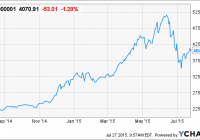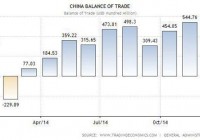
Summary The Shanghai index fell more than 8% today, marking the greatest loss in almost a decade. Investing in China has always been notoriously difficult for foreigners. Fortunately, there are a small handful of inverse ETF’s that allow foreign investors to possibly profit off the Chinese downturn; this article will offer a brief overview of these companies. Introduction One of the few people to get rich in the 1929 crash was a man named Jesse Livermore, or ‘boy plunge’, who made over $100 million during a period when almost everyone else in the industry went broke. In 2006, hedge fund manager John Paulson made one of the most famous bets in Wall Street history when he bet millions against the sub-prime housing market using credit default swaps, which quickly turned him into a billionaire. Did the Chinese stock market just create the next big short-selling opportunity? There is a lot of media coverage with respect to the ‘China Bubble’, however, I could not find anything that offered an overview of the best way to capitalize off of the bubble for the Western investor. This article will offer a brief overview of the performance of the Chinese stock market, but will not go into as much detail as this has been covered before; instead, the focus of this article will be on how to possibly benefit from an overvalued stock market bubble. The China Bubble ^SS000001 data by YCharts Last month, China finally started a much anticipated turn around in their overheated stock market. Much of this fall was in the Shanghai index, which has a lot of the more expensive tech stocks, with very high P/E ratios. Most investors have little to no experience about investing in China as government policies have historically made this difficult, up until loosening of said policies within the last few months. Furthermore, the Chinese government plans to possibly place restrictions on foreign short-selling of Chinese securities, which has further confounded the picture for foreign investors. China’s stock market has been rising without anything slowing it down for several years now; most notably, within the last year the Shanghai index has absolutely exploded by more than doubling in value. It’s important to note that within the last six months, a large number of retail investors have entered the picture in China, seemingly under the premise that the Chinese markets could never go down; this has led to prices surging, especially on the Shanghai index, as many of these poorly educated investors spent money haphazardly. This has led to the stock price deviating significantly from the fundamentals, and created a bubble. A couple of weeks ago that bubble started to burst as the Shanghai index went from above 5000 to 3500; this stall seemed to have stabilized after the Chinese government announced loosening of margin requirements, halted the trading of certain corporations, and facilitated massive amounts of promised investments from large corporations until the Shanghai index hit 4500. This seemed to create some stabilization pressure as the Shanghai index fought to stay above 4000; today the Shanghai index fell more than 8% for it’s largest drop in almost a decade. The Fundamentals The strongest belief that I have with regards to investing is that your decisions should be based on 99% fundamentals, and 1% reading chart trends. Every day I am perplexed by the masses of people who spend hours looking at charts, technical indicators, and ‘doji’s’, without once pulling up the latest quarterly report, reading the news, and crunching the numbers. I don’t understand people that solely make their investment decisions based on how other people chose to buy or sell that stock, over a certain period of time in the past. The 1% of your effort that you should spend on reading charts, is specifically ideal for this type of situation. We know the market is overvalued, yet we don’t know when people will come down to reality. In short, I think that it makes sense to ignore the momentum of a stock and base decisions purely on the fundamentals; however, when it comes to make a riskier short bet it seems logical to look for the momentum indicator to confirm a decision based on the fundamentals. This is because one’s losses are finite in a long, but theoretically infinite in a short. Looking at the fundamentals for China can be quite terrifying. The most touted metric in the media seems to be the absurd price to earnings ratios that are emerging. Furthermore, the average P/E seems to be skewed as there are a large number of banks that are trading at 12 P/E, while technology stocks are trading in the mid 60’s. How to Invest Against China? Most investors tend to purchase stocks in their own currency, and on exchanges in their own country. This is because most people generally feel more comfortable investing in their own currency because they don’t want to deal with the unknown variables such as exchange rates. Also, we tend to get an over proportionate amount of news, and tend to learn more about our own economy, making us more confident to invest. People tend to invest in areas they know more about, which is why amateurs investors tend to invest in fields they work in, or may have an expertise in. This is of course generally a good idea, as you don’t ever want to invest in something before you fully understand a company. I will admit that I am far from an expert in Asian markets, and when I do pay attention to Asia I tend to focus on the macroscopic picture, rather than individual companies. I think hat the vast majority of Western investors think along the same lines, and find it confusing to invest in any one company in Asia. Fortunately, there are exchange traded funds (ETFs) that makes the job a whole lot easier. I’ll go over some of them below. Based on my research I was able to find 3 ETFs that short the Chinese markets, some of them using leverage; this article will offer a brief overview of all three. I think it is important to understand how an ETFs like these work, as it can be quite hard to understand. All of these ETFs are daily inverse ETFs, and therefore should closely match the corresponding index for one day. However, for the leveraged ETF’s, they tend to look much different than the actual index due to the compounding effect of leverage. For example, with a triple inverse ETF, the index could lose 90% of its value in one day, then double the next, resulting in you losing all of your money. It’s important to understand how quickly one can lose or make money with this environment. With the extraordinary manipulation of the Chinese markets, this can be an extremely dangerous trade. The ETFs CHAD data by YCharts ProShares Short FTSE China 50 ETF (NYSEARCA: YXI ) and ProShares UltraShort FTSE China 25 ETF (NYSEARCA: FXP ) The Proshares Short China 50 FTSE is an ETF which is designed to correspond to the inverse of the China 50 FTSE, while the Proshares Ultrashort China 50 FTSE corresponds to twice the inverse. The China 50 FTSE includes the 50 largest stocks on the Hong Kong Stock Exchange, which has almost half of their investments in the finance sector, with under 4% in technology. The table below made available by Proshares outlines their asset distribution. Keep in mind that this index has not been the focus of attention recently. Direxion Daily FTSE China Bear 3x Shares ETF (NYSEARCA: YANG ) The Direxion Daily China Bear 3X Shares ETF is essentially the Proshares ETF on steroids; for the investor with nerves of steel, one can return three times the inverse of the China 50 FTSE. This is the most leveraged Chinese ETF available, but again it corresponds to the top 50 most liquid companies in China, and would not necessarily be the most profitable in the event of a collapse. Direxion Daily CSI 300 China A Share Bear 1X Shares (NYSEARCA: CHAD ) The Direxion Daily CSI China A Bear 1x Shares most recently added Chinese bear ETF, and it directly corresponds to the most controversial index: The China A shares. Chinese A shares are ordinarily restricted to Chinese citizens, and are traded on the Shanghai and Shenzen Stock Exchange; foreign investors must go through the Qualified Foreign Institutional Investor system. Fortunately, we can still take advantage of the situation through CHAD! Although this is not a leveraged ETF, it corresponds to the most volatile part of the Chinese stock market, and may be the most likely to produce the most profit in the event of a downturn. Conclusion Although I still believe that the Chinese markets are inflated, the government intervention makes this far too speculative for me; I bought all three of these ETFs right before the crash last month, and settled them a couple of weeks ago to play it safe. However, for the more aggressive investor, there are still ways to profit off the potential collapse of the Chinese markets. Disclosure: I/we have no positions in any stocks mentioned, and no plans to initiate any positions within the next 72 hours. (More…) I wrote this article myself, and it expresses my own opinions. I am not receiving compensation for it (other than from Seeking Alpha). I have no business relationship with any company whose stock is mentioned in this article. Additional disclosure: Used to own all three but sold a couple of weeks ago.

